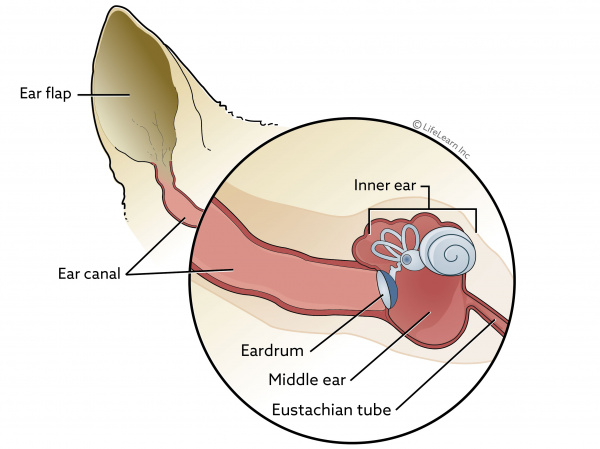Tympanic Membrane Rupture and Middle Ear Infection in Cats
The tympanic membrane or eardrum is a thin membrane that separates the outer ear canal from the middle and inner ear.
The middle ear contains the three tiniest bones in the body, the malleus, incus and stapes, more commonly referred to as the hammer, anvil, and stirrup. The eustachian tubes are also located in the middle ear.
My cat has been diagnosed with a middle ear infection. What is it?
If the eardrum is perforated or tears, bacteria and fungi from the outer ear canal may enter the sensitive middle ear resulting in middle ear infection (otitis media). A middle ear infection can also result from a polyp or mass (benign or malignant tumor) in the middle ear.
What causes a ruptured eardrum?
A ruptured eardrum can be the result of trauma, infection, exposure to toxins, sudden severe changes in atmospheric pressure, very loud noises, and foreign objects.
How can I tell if my cat has ruptured her eardrum or has a middle ear infection?
Most cases of ruptured eardrum and middle ear infection will be identified by your veterinarian. Signs that your cat has a ruptured eardrum or middle ear infection can include discharge from the ear (often thick and pus-like or bloody), sudden hearing loss, red and inflamed ear canal, pain when touching the ear, a head tilt, stumbling and incoordination, and darting of the eyes back-and-forth (nystagmus). Facial nerve paralysis causing drooping of one side of the face and mouth and the inability to blink or a completely closed eyelid may occur in some cases. Middle ear infections are often accompanied by inner ear infections and disruptions of balance and equilibrium.
"A cat that is tilting his head or experiencing any
pain around the ears should be taken seriously."
A thorough ear examination, sometimes requiring sedation or anesthesia, is necessary to diagnose a ruptured eardrum. Many cats will require warm saline flushes. A classic test is to look for tiny air bubbles that form deep in the ear canal when the cat breathes. Another common test is to infuse a special dye, fluorescein, into the ear canal. If it escapes and exits through the nose, the eardrum is ruptured.
A special test called a myringotomy is usually performed in cases of middle ear infections. A myringotomy involves obtaining a sterile sample of the fluid within the middle ear for culture and analysis. A myringotomy is performed under sedation or anesthesia and is usually part of the thorough ear examination. Your veterinarian will discuss whether or not this diagnostic test is necessary for your cat.
Skull radiographs (X-rays) are often helpful in determining the severity of a middle ear infection. CT and MRI scans are also recommended in some cases and provide certain diagnostic advantages.
How are these conditions treated?
A thorough ear flushing, usually under sedation or anesthesia, is required in most cases. Your veterinarian will use appropriate medications and sometimes water-based flushing solutions (most often TrizEDTA). Topical antibiotics (such as Baytril® Otic) may be prescribed based on your cat’s specific condition. Oral antibiotics (such as amoxicillin/clavulanate, enrofloxacin, cefpodoxime, or marbofloxacin) and/or antifungal medications (itraconazole is preferred) are used in many cases. In addition, systemic corticosteroids (steroids) most typically prednisone, may be beneficial in cats that have severe inflammation and pain but also have the side effect of exacerbating signs associated with infection.
Some patients will require surgery. In these cases, your veterinarian will discuss with you the reasons for a surgical procedure, risks involved, and expected outcomes. Surgery is typically reserved for cases thought to have severe, irreversible changes of the outer ear with occurring at the same time as a middle ear infection.
What is the prognosis?
The majority of patients heal without significant complications. Most ruptured eardrums heal without surgery within three to five weeks. Middle ear infections may require oral antibiotics or antifungal medications for six to eight weeks. Most cats will require frequent recheck examinations and follow-up care to ensure the infection is resolving and the eardrum is healing properly. It is critical that you closely follow your veterinarian’s instructions to prevent serious complications or prolonged healing. In severe cases with nerve damage, there may be permanent changes in the face, lips, and eyes or hearing loss. Your veterinarian will provide you with a more accurate prognosis based on your cat’s specific condition.






